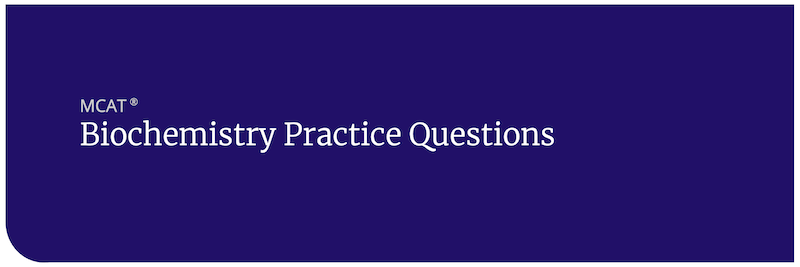MCAT Practice Questions: Biochemistry
The MCAT will present you with 10 passages on biology and biochemistry topics, and ask 4-7 questions about each passage. The questions will address the four skills listed, although not every passage will require you to use each skill. You will also be presented with 15 discrete questions that are not associated with passages. These will also be designed to test both your science knowledge and application of that knowledge based on these four skills. You can find more details on what you need to know about the overall structure of the MCAT here.
The biology/biochem section of the MCAT is scored on a curved scale of 118-132, with the median score of all test takers set at 125. There is no specific number of right or wrong questions that corresponds to a given scaled score; instead, each test administration is curved according to its level of difficulty and the performance of the test-takers on that day. The score for this section of the test is combined with the other three sections to give an overall score ranging from 472 to 528.
MCAT Practice Questions: Biochemistry
Answer and Explanation
The correct answer is: B
Protein activity and concentration are generally correlated. Because we have a high concentration of protein, we expect a high activity unless the protein has been damaged or inactivated in some way. The protein could have been inactivated by experimental conditions like detergents, heat, or pH; however, these are not answer choices. Rather, we must consider how the experimental procedure works. Protein elutes off of an affinity column by binding free ligand. In this situation, the binding may not have been reversed and thus the free ligand competes for the active site of the enzyme, lowering its activity.
Answer and Explanation
The correct answer is: A
In this table, we are given the sequence of the sense (coding) DNA strand. This will be identical to the mRNA transcript, except all thymine nucleotides will be replaced with uracil. With the deletion of these three bases, codon 507 changes from AUC to AUU in the transcript; these both code for isoleucine due to wobble. However, codon 508 (UUU in the transcript) has been lost. UUU codes for phenylalanine. The C-terminus sequence will remain unchanged because the deletion of three bases (exactly one codon) will not throw off the reading frame. For reference, the mutant reading frames would be:
| AUC | AUU | GGU | GUU | UCC |
MCAT Strategy Tips
Although the designers of the MCAT will provide physiological facts and numbers, that’s not what you’re expected to know before taking the exam. Your MCAT practice will require being able to see the same concepts that you learned in your undergraduate pre-med classes in a very defined and isolated environment—applied in a foreign scope to integrated sciences.
The interplay of scientific disciplines (i.e., how your knowledge of physics or chemistry informs your understanding of how an organ works) is paramount to your success both on the new MCAT and as a future physician. The human body is a network of interdependent physical, chemical, and biological processes, and the MCAT measures your ability to make those connections.
Knowing formulas and reactions is necessary for success on the MCAT, but will in no way be sufficient. Success will only come with practice, so here are a couple of tips:
Tip 1: When studying a “physical” science, think through all of its biological applications.
For example, let’s use reduction and oxidation. We know that LEO the Lion says GER (the Loss of an Electron is Oxidation and the Gain of an Election is Reduction). Therefore, when a metal is losing or gaining electrons, it’s either getting oxidized or reduced, respectively.
Don’t stop there. The ReDox that occurs in the Electron transport chain, with NADH losing an electron to the ETC and getting—you guessed it—oxidized, is the exact same concept. NAD+ is the product of the oxidation of NADH, just as Ag+ is the oxidized product of Ag. It’s the exact same science. So, don’t get thrown off by the fact that you learned it in two different places.
Tip 2: There are a finite number of scientific facts.
There is some truth in the claim that most of biology is rooted in chemistry and physics. Take proteins for example. We think of them as biological molecules because they serve such a prominent role in the body. In reality, they are nothing more than a very specific structural arrangement of carbon, nitrogen, oxygen, hydrogen, and sometimes sulfur.
The way in which they are bonded to each other is through a bonding orbital—just like the ones you learned about in general chemistry. They fold into specific shapes because of attractions and repulsions of the amino acids in their sequence. Those are the same attractions and repulsions seen in chemistry. The proteins themselves are coded from RNA, which is coded from DNA. RNA and DNA are just chemical molecules with the same properties you learned about in chemistry.

